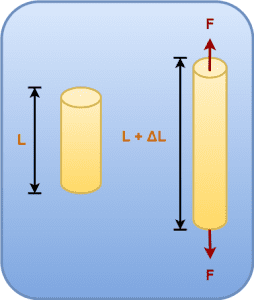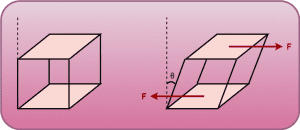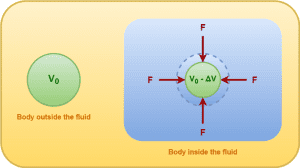Mechanical Properties of Solids-
Before you go through this article, make sure that you have gone through the previous article on Introduction to Elasticity.
We have learnt-
- Under the action of deforming force, the original configuration of the body changes.
- The molecules of the body suffers a relative displacement which gives rise to a restoring force.
- The restoring force developed inside the body tries to restore its original configuration.
In this article, we will learn about stress and its types.
Stress-
In mechanical properties of solids, stress is defined as-
| The restoring force per unit area of the body is called as stress. |
The restoring force is equal and opposite to the deforming force. Therefore,
| Stress may also be defined as the deforming force per unit area of the body. |
Mathematically,

Characteristics of Stress-
- The SI unit of stress is newton per square meter (N/m2).
- The unit of stress is also a pascal (Pa). 1 Pa = 1 Nm-2
- The dimensional formula of stress is same as that of pressure i.e. [ML-1T-2]
- Stress is a scalar quantity.
- The effect of stress is to produce distortion i.e. change the original configuration of the body.
Types of Stress-

Let us discuss all types of stress one by one in detail.
1. Normal Stress or Longitudinal Stress-
It is of two types-
- Tensile Stress
- Compressive Stress
Tensile Stress-
- When two equal and opposite forces are applied at the ends of a solid rod to increase its length, then the body is under tensile stress.
- Under tensile stress, a restoring force equal to the applied force normal to the cross-sectional area of the rod comes into existence.
- This restoring force acting per unit area perpendicular to the cross-section of the body is called as tensile stress.

Compressive Stress-
- When two equal and opposite forces are applied at the ends of a solid rod to decrease its length or to compress it, then the body is under compressive stress.
- Under compressive stress, a restoring force equal to the applied force normal to the cross-sectional area of the rod comes into existence.
- This restoring force acting per unit area perpendicular to the cross-section of the body is called as compressive stress.

2. Tangential Stress or Shearing Stress-
- When two equal and opposite forces act along the tangents to the surfaces of the opposite faces of an object, then the object is under shearing stress.
- Under shearing stress, one face of the object is displaced with respect to the other face.
- The ratio of the force acting along the tangent to the surface to the area of the surface is called as shearing stress.

3. Bulk Stress or Volume Stress or Hydraulic Stress-
- When an object is immersed in a fluid (liquid or gas), the fluid exerts force on the surfaces of the object, then the object is under bulk stress.
- Under bulk stress, the volume of the object decreases.
- The ratio of the force acting perpendicular to the surface of the object per unit area of the object is called as bulk stress.

Read the next article on-
Get more notes & other study material of the Chapter Mechanical Properties of Solids.

